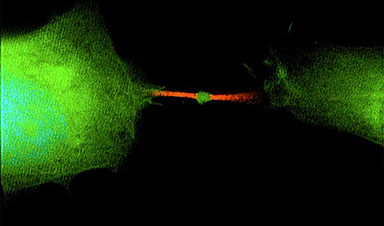Once thought to be the trash can of the cell, a little bubble of cellular stuff called the midbody remnant is actually packing working genetic material with the power to change the fate of other cells—including turning them into cancer.
“One cell divides into three things: two cells and one midbody remnant, a new signaling organelle,” says Skop. “What surprised us is that the midbody is full of genetic information, RNA, that doesn’t have much to do with cell division at all, but likely functions in cell communication.”
In a study published today in the journal Developmental Cell, Skop’s lab and collaborators from the Pasteur Institute in Paris, Harvard Medical School, Boston University and the University of Utah analyzed the contents of midbodies—which form between the daughter cells during division—and tracked the interactions of the midbody remnants set free after cell division. Their results point to the midbody as a vehicle for the spread of cancer throughout the body.
“People thought the midbody was a place where things died or were recycled after cell division,” Skop says. “But one person’s trash is another person’s treasure. A midbody is a little packet of information cells use to communicate.”
The midbody’s involvement in cell signaling and stimulating cell proliferation has been investigated before, but Skop and her collaborators wanted to look inside the midbody remnants to learn more.
What the researchers found inside midbodies was RNA—which is a kind of working copy of DNA used to produce the proteins that make things happen in cells—and the cellular machinery necessary to turn that RNA into proteins. The RNA in midbodies tends to be blueprints not for the cell division process but for proteins involved in activities that steer a cell’s purpose, including pluripotency (the ability to develop into any of the body’s many different types of cells) and oncogenesis (the formation of cancerous tumors).
“A midbody remnant is very small. It’s a micron in size, a millionth of a meter,” Skop says. “But it’s like a little lunar lander. It’s got everything it needs to sustain that working information from the dividing cell. And it can drift away from the site of mitosis, get into your bloodstream and land on another cell far away.”
Many midbody remnants are reabsorbed by one of the daughter cells that shed them, but those that touch down on a distant surface, like a lunar lander, may instead be absorbed by a third cell. If that cell swallows the midbody, it may mistakenly begin using the enclosed RNA as if it were its own blueprints.
Previous research showed that cancer cells are more likely than stem cells to have ingested a midbody and its potentially fate-altering cargo. Stem cells, which give rise to new cells and are valuable for their pluripotency, spit a lot of midbodies back out, perhaps to maintain their pluripotency.
Future research may be able to harness the power of midbody RNA to deliver drugs to cancer cells or to keep them from dividing.
“We think our findings represent a huge target for cancer detection and therapeutics,” says Skop, whose work is supported by the National Institutes of Health.
The researchers identified a gene, called Arc, that is key to loading the midbody and midbody remnant with RNA. Taken up long ago from an ancient virus, Arc also plays a role in the way brain cells make memories.
“Loss of Arc leads to the loss of RNA in the midbody and a loss of the RNA information from getting to recipient cells,” Skop says. “We believe this memory gene is important for all cells to communicate RNA information.”
Sungjin Park, a senior scientist in Skop’s lab, is the lead author of the new study. Skop and collaborators also have a patent pending on two new methods that make it easier to isolate midbody structures from cell media or blood serum, improving cancer diagnostics.
News
Two New Books From Frank Boehm, NA Founder – To be Released Dec. 2025
Molecular Manufacturing: The Future of Nanomedicine This book explores the revolutionary potential of atomically precise manufacturing technologies to transform global healthcare, as well as practically every other sector across society. This forward-thinking volume examines [...]
What could the future of nanoscience look like?
Society has a lot to thank for nanoscience. From improved health monitoring to reducing the size of electronics, scientists’ ability to delve deeper and better understand chemistry at the nanoscale has opened up numerous [...]
Scientists Melt Cancer’s Hidden “Power Hubs” and Stop Tumor Growth
Researchers discovered that in a rare kidney cancer, RNA builds droplet-like hubs that act as growth control centers inside tumor cells. By engineering a molecular switch to dissolve these hubs, they were able to halt cancer [...]
Platelet-inspired nanoparticles could improve treatment of inflammatory diseases
Scientists have developed platelet-inspired nanoparticles that deliver anti-inflammatory drugs directly to brain-computer interface implants, doubling their effectiveness. Scientists have found a way to improve the performance of brain-computer interface (BCI) electrodes by delivering anti-inflammatory drugs directly [...]
After 150 years, a new chapter in cancer therapy is finally beginning
For decades, researchers have been looking for ways to destroy cancer cells in a targeted manner without further weakening the body. But for many patients whose immune system is severely impaired by chemotherapy or radiation, [...]
Older chemical libraries show promise for fighting resistant strains of COVID-19 virus
SARS‑CoV‑2, the virus that causes COVID-19, continues to mutate, with some newer strains becoming less responsive to current antiviral treatments like Paxlovid. Now, University of California San Diego scientists and an international team of [...]
Lower doses of immunotherapy for skin cancer give better results, study suggests
According to a new study, lower doses of approved immunotherapy for malignant melanoma can give better results against tumors, while reducing side effects. This is reported by researchers at Karolinska Institutet in the Journal of the National [...]
Researchers highlight five pathways through which microplastics can harm the brain
Microplastics could be fueling neurodegenerative diseases like Alzheimer's and Parkinson's, with a new study highlighting five ways microplastics can trigger inflammation and damage in the brain. More than 57 million people live with dementia, [...]
Tiny Metal Nanodots Obliterate Cancer Cells While Largely Sparing Healthy Tissue
Scientists have developed tiny metal-oxide particles that push cancer cells past their stress limits while sparing healthy tissue. An international team led by RMIT University has developed tiny particles called nanodots, crafted from a metallic compound, [...]
Gold Nanoclusters Could Supercharge Quantum Computers
Researchers found that gold “super atoms” can behave like the atoms in top-tier quantum systems—only far easier to scale. These tiny clusters can be customized at the molecular level, offering a powerful, tunable foundation [...]
A single shot of HPV vaccine may be enough to fight cervical cancer, study finds
WASHINGTON -- A single HPV vaccination appears just as effective as two doses at preventing the viral infection that causes cervical cancer, researchers reported Wednesday. HPV, or human papillomavirus, is very common and spread [...]
New technique overcomes technological barrier in 3D brain imaging
Scientists at the Swiss Light Source SLS have succeeded in mapping a piece of brain tissue in 3D at unprecedented resolution using X-rays, non-destructively. The breakthrough overcomes a long-standing technological barrier that had limited [...]
Scientists Uncover Hidden Blood Pattern in Long COVID
Researchers found persistent microclot and NET structures in Long COVID blood that may explain long-lasting symptoms. Researchers examining Long COVID have identified a structural connection between circulating microclots and neutrophil extracellular traps (NETs). The [...]
This Cellular Trick Helps Cancer Spread, but Could Also Stop It
Groups of normal cbiells can sense far into their surroundings, helping explain cancer cell migration. Understanding this ability could lead to new ways to limit tumor spread. The tale of the princess and the [...]
New mRNA therapy targets drug-resistant pneumonia
Bacteria that multiply on surfaces are a major headache in health care when they gain a foothold on, for example, implants or in catheters. Researchers at Chalmers University of Technology in Sweden have found [...]
Current Heart Health Guidelines Are Failing To Catch a Deadly Genetic Killer
New research reveals that standard screening misses most people with a common inherited cholesterol disorder. A Mayo Clinic study reports that current genetic screening guidelines overlook most people who have familial hypercholesterolemia, an inherited disorder that [...]





















